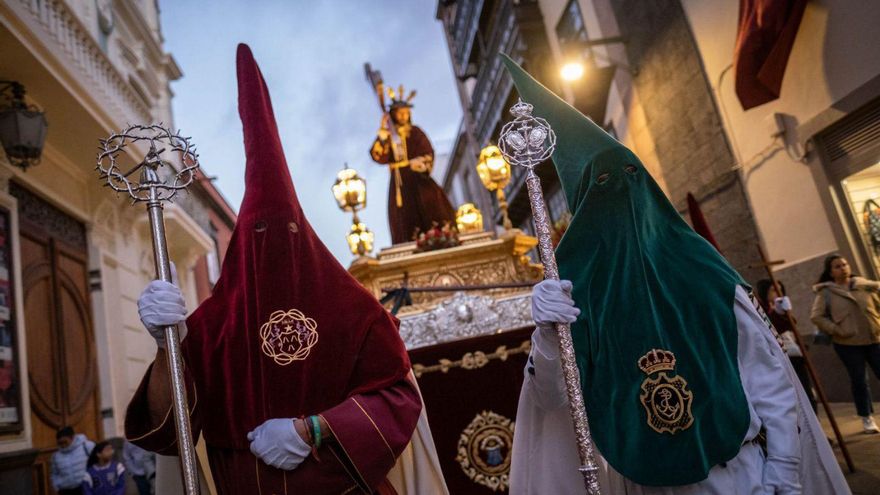
The processions are prepared for weeks and often the weather and its inclemencies have the last word. It happens throughout Spain and also in La Laguna, where Holy Wednesday dawned cold and rainy, with the consequent nerves among the brotherhoods that parade on this day. The particularity is that several of the images, such as the Nazarene, Soledad and Ecce Homo, have a close historical link with the church of San Agustín, which burned in 1964.
In the Cathedral, at mid-morning, the last preparations were made. Confraternities of Nuestro Padre Jesús Nazareno and Nuestra Señora de la Soledad placed the steps for the Eucharistic celebration in the afternoon, while the Very Old and Venerable Brotherhood of the Blood of Christ and the Holy Cross also solved some details. The latter’s older brother, Jorge Melón, pointed out that he had already prepared everything a few days ago, while the previous hours were dedicated to minor aspects.
Finally, time allowed the processions to take to the streets. The events were scheduled to begin at 6:30 p.m. with a performance by the Band of Bugles and Drums of San Miguel in the Plaza del Hermano Ramón, a remembered religious from La Salle, a school linked to the Brotherhood of Our Father Jesus Nazareno and Our Lady of Solitude. Already at 7:00 p.m. the Eucharistic celebration took place in honor of Our Father Jesus Nazareno and Our Lady of Solitude, during which the habits of the new members were blessed, and then the procession was held, in which the procession of Ecce Homo (popularly known as the Lord of the Cañita) also paraded, accompanied by the Brotherhood of Blood.
At the same time, at 6:30 p.m., a Eucharist was celebrated in the parish of San Benito, followed by the procession of Veronica and the Holy Face, accompanied by their penitential brotherhood. This step made a parade apart from the one carried out in the historic center by the three previous thrones.
The Brotherhood of Nuestro Padre Jesús Nazareno and Nuestra Señora de la Soledad dates from 1953. According to the website of the Board of Brotherhoods and Brotherhoods (JHC) of La Laguna, “it was founded by students and former students of the Nava-La Salle College, who previously already accompanied the procession of the Nazarene and the Sorrowful ». Among its images is Nuestro Padre Jesús Nazareno, acquired in Valencia and which arrived in La Laguna at the beginning of the 20th century. “It could have been rescued from the church of San Agustín during the 1964 fire, although it had to be restored,” the portal collects.
great value carvings
Our Lady of Solitude is the work of the Laguna sculptor and painter José Rodríguez de la Oliva (1695-1777), and is considered “his model of Dolorosa”. According to data from the JHC, since the 18th century she has accompanied Jesús Nazareno in the procession on Holy Wednesday, when she was already venerated as Virgen de los Dolores. Later she would also leave on Good Friday night in the Retiro procession, from the Cathedral to the church of San Agustín.
For its part, the Very Old and Venerable Brotherhood of the Blood of Christ and the Holy Cross was founded in 1950 and is heir to the Brotherhood of Blood, established just two decades after the conquest of Tenerife in the Augustinian convent of the Holy Spirit. Ecce Homo, popularly known as the Señor de la Cañita, is a work by Ezequiel de Lion. «He received the commission in 1964, after the old image was lost in the fire of the Church of San Agustín, the model from which the sculptor started, who did not limit himself to reproducing it, but carved a personal work valued as one of the best in his catalogue. It was blessed on March 14, 1965 –Holy Wednesday– in the church of Nuestra Señora de La Concepción, and that same night it went out for the first time in procession accompanied by the Brotherhood of the Blood», the brother’s website collects.
As for the Cofradía de la Santa Faz, “after obtaining the approval of the statutes by the bishop, it joined the Board of Brotherhoods in 1981”, while, “in March of that year, after the blessing of the image of La Verónica, the brotherhood went out in procession for the first time, incorporating a new step and a new neighborhood into Holy Week in La Laguna, that of San Benito». The JHC indicates: «The passage is the result of various modifications that have managed to convey the scene of Christ’s encounter with Veronica with a narrative sense, who wipes his bloody face, leaving the Holy Face reflected on the cloth. The image of the Lord and that of the Samaritan woman (primitive Verónica) were made by Ezequiel de León in 1990 and 1980, respectively; and that of Verónica, by Juan Ventura in 1995».
















